Annuals in the Perennial Garden
Plants For A Future has always focused on providing information about, and encouraged the cultivation and use of, perennial plants. But this does not mean that we discourage the growing of annual plants. This section will look at ways of including many of the conventional annual crops in a perennial garden and will also look at a number of less well-known annuals such as Chinese mallow and pearl lupin. We use the term ‘annual’ in a rather loose sense to depict those plants we usually cultivate as annual crops (such as runner beans), rather than just limit ourselves to the true annuals that complete their entire life cycle within a year.
Of course, as outlined in the first section of this book, we do not like the idea of growing lots of the same plant in straight lines. We have found that, the more of any one species that is grown together than the greater the chance of problems with pests and diseases. Thus, if you want to grow annual plants, we recommend integrating them as far as possible with the perennial species. This is not always easy, and there are a number of annual plants that just do not fit easily into a perennial system, but it is surprising how many can do well there.
There are a number of advantages and disadvantages with integrating annuals. The disadvantages include: ¬
- The plants are more scattered and so harvesting of some crops such as carrots and peas can be more complicated as you have to wander here and there in order to harvest sufficient quantity.
- You have to be very careful in selecting spots in which to grow the plants, since the perennials around them will often grow rapidly and swamp out the annuals before they can establish themselves.
- It can be hard for the annuals to establish themselves due to the established root systems of the perennials.
- It can be difficult to harvest some crops, especially the larger root crops, since digging them up can disturb the roots of the perennial species.
The advantages include:-
- There are a wide range of benefits to the soil and ecosystem - see our leaflet Why Perennials.
- By scattering your plants amongst the perennials, many problems with pests and diseases can be greatly reduced.
- By selecting complementary growth habits, such as allowing peas to clamber into small shrubs, it is possible to grow more crops in the same area of ground and thus increase overall productivity.
When deciding how to place annuals in the perennial garden, it is important to look at the needs, growth habit and life cycle of each species. The vast majority of cultivated annual food plants are best adapted for growing in sunny situations (many of them such as cabbages, beet and carrots were originally sea-shore plants) Therefore, when selecting a position to grow them amongst annuals you usually need to focus upon the sunnier spots. Very poor results will be obtained if they are grown in the shade, though there are exceptions to this rule that will be noted when dealing with individual species. You also need to take into account the likely size of the annuals you are growing and the perennials that will surround them.
Some plants, such as onions, are very narrow and can fit into smaller places, whilst others such as broccoli are much more spreading and will need quite a bit of space.
We have found that annuals can generally be grown using one of the following methods:-
- Aggressive self-sowers. If allowed to flower and set seed, several annual crops, such as spinach beet and land cress, are more than capable of maintaining themselves year by year so long as they have some bare soil in which their seeds can germinate.
- Sowing in situ each year. Crops such as radish, peas, onion sets and turnips germinate rapidly and grow sufficiently fast that they can be sown directly into suitable gaps between the perennials.
- Sowing in pots. Many crops, such as French beans, tomatoes, sweet corn and lettuce can be started off in pots or trays in the greenhouse and then planted out into the garden when sufficiently large.
- The pains in the butt. A few crops, particularly carrots, are quite difficult and labour intensive to grow and/or harvest in an annual garden. They germinate quite slowly, dislike transplanting, and generally do not compete well with the perennials.
A few crops, particularly carrots, are quite difficult and labour intensive to grow and/or harvest in an annual garden. They germinate quite slowly, dislike transplanting, and generally do not compete well with the perennials.
We will now look in more detail at the different methods of growing the annuals and which plants fit into which categories. The more conventional food crops will be mentioned in their respective categories, but will not be looked at in detail since more information on these plants can easily be found in conventional gardening books. However, we will look in more detail at those plants that are not so well known as food crops. In all cases we will try to give approximate likely sizes of the plants (height and width) to help you to work out where to place the plants. Please note, sizes are based on how large you are likely to let the plants grow before harvesting them rather than the ultimate size of the plant. Thus where plants are usually harvested and removed before going to seed the size given will be based on size at harvest rather than at flowering.
Group 1 - the aggressive self-sowers
These are plants that, once established, are generally able to maintain themselves for a number of years by self-sowing. Establishment usually takes the form of simply sowing the seeds in selected spots in the garden. There are two factors in particular that you need to take into account. Firstly, you need to allow at least some of the plants to flower and set seed -in general always allow at least three plants to do this, selecting the three best plants where possible to try and ensure good quality plants in future generations. Secondly, the seed will need some bare earth in which to germinate - we have found that simply hoeing small areas amongst the perennials is sufficient for this.
The seed is sown in situ. Firstly, you select suitable spaces amongst the perennials - since most seed sowing takes place in the spring you do need a certain amount of imagination to try and picture just how large the perennials are likely to grow over the following months and make sure the spaces you have selected are large enough. The soil is prepared by hoeing it to make a good tilth and then sowing the seed. Even in wet seasons it is necessary to make sure that the soil remains moist enough for the seed to germinate since the ground around perennials can be much drier than in a conventional vegetable garden. In drier seasons it is often wise to wet the soil thoroughly before sowing the seed and also to cover it with something like a sheet of newspaper for a few days after sowing to ensure the moisture remains in the soil. Do not leave it covered for too long, however, since many seeds require light for germination.
There are many interesting and useful plants that will self-sow and look after themselves very well, though not many of these are the better known conventional crops - this is at least partly due to the fact that these have actually been selectively bred over many centuries and have lost the vitality that allows many annuals to become weeds in the garden. In addition, where growing named varieties, it is important to remember that there is a very strong chance the future generations will not breed true since pollinating insects will not mind spreading the pollen around with any wild forms of the plant or other named varieties growing nearby.
The best known vegetable in this section is spinach beet, Beta vulgaris cicla (90cm x 40cm). This is a very productive plant that self-sows very easily and is very worthy of a place in the garden.
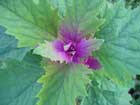 Atriplex hortensis. (180cm x 30cm) Orach is another of those plants with a long history of cultivation, though it is rarely used as a food nowadays. The leaves can be cooked and used like spinach, they have a bland flavour and are traditionally mixed with sorrel leaves in order to modify the acidity of the latter. There are some very ornamental varieties available with bronze or deep red leaves that do not look at all out of place in the flower border - the flavour of these is virtually the same as green leaved forms and they also tend to breed true, so it is possible to use these as self-sowing food crops.
Atriplex hortensis. (180cm x 30cm) Orach is another of those plants with a long history of cultivation, though it is rarely used as a food nowadays. The leaves can be cooked and used like spinach, they have a bland flavour and are traditionally mixed with sorrel leaves in order to modify the acidity of the latter. There are some very ornamental varieties available with bronze or deep red leaves that do not look at all out of place in the flower border - the flavour of these is virtually the same as green leaved forms and they also tend to breed true, so it is possible to use these as self-sowing food crops.
.jpg) Barbarea verna. (30cm x 25cm) The leaves of land cress have a hot, spicy watercress flavour that makes a delicious addition to mixed salads. Once this plant is established in your garden it will usually self-sow quite freely and is able to germinate and thrive even in quite strong weed competition; it will even grow in a lawn. In mild climates you may be able to pick leaves all the year round, in colder climates the plant is likely to die down during the winter but will be back very quickly in the spring.
Barbarea verna. (30cm x 25cm) The leaves of land cress have a hot, spicy watercress flavour that makes a delicious addition to mixed salads. Once this plant is established in your garden it will usually self-sow quite freely and is able to germinate and thrive even in quite strong weed competition; it will even grow in a lawn. In mild climates you may be able to pick leaves all the year round, in colder climates the plant is likely to die down during the winter but will be back very quickly in the spring.
 Chenopodium album. (90cm x 20cm) Most gardeners are more likely to think of fat hen as a weed rather than as a food crop, but this plant does have a long history of use as a food. Indeed, there is at least one named variety - called ‘Magenta’, it is considered by some people to be one of the very best tasting of all potherbs. If you grow ‘Magenta’ then it is important to remember that it will almost certainly not breed true but will cross with the wild form to produce a mixture of seedlings. Since fat hen is such a common weed, you do not usually have to work at establishing it in your garden - it will usually turn up with or without an invitation! Once it is there, you can use it in a number of ways. The leaves make a very acceptable spinach substitute - the taste is a little bland but this can be improved by adding a few stronger-flavoured leaves. The young flowering heads can be harvested and cooked in the same way as broccoli - they make a very tasty alternative to that plant. The seed is also edible and very nutritious. It is rather small and the easiest way of utilizing it is to ground it into a flour and add it to conventional wheat flour when making cakes, bread etc. The seed does need to be soaked for 12 hours in water beforehand in order to leech out a bitter substance found on the outside of the seed (you can use this water as a hair wash, or spray it over plants to act as a bird deterrent).
Chenopodium album. (90cm x 20cm) Most gardeners are more likely to think of fat hen as a weed rather than as a food crop, but this plant does have a long history of use as a food. Indeed, there is at least one named variety - called ‘Magenta’, it is considered by some people to be one of the very best tasting of all potherbs. If you grow ‘Magenta’ then it is important to remember that it will almost certainly not breed true but will cross with the wild form to produce a mixture of seedlings. Since fat hen is such a common weed, you do not usually have to work at establishing it in your garden - it will usually turn up with or without an invitation! Once it is there, you can use it in a number of ways. The leaves make a very acceptable spinach substitute - the taste is a little bland but this can be improved by adding a few stronger-flavoured leaves. The young flowering heads can be harvested and cooked in the same way as broccoli - they make a very tasty alternative to that plant. The seed is also edible and very nutritious. It is rather small and the easiest way of utilizing it is to ground it into a flour and add it to conventional wheat flour when making cakes, bread etc. The seed does need to be soaked for 12 hours in water beforehand in order to leech out a bitter substance found on the outside of the seed (you can use this water as a hair wash, or spray it over plants to act as a bird deterrent).
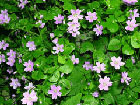 Claytonia species. (15cm x 15cm) Miner’s lettuce, C. perfoliata, and pink purslane, C. sibirica, are low growing plants that, once established, will usually self-sow with abandon. It is easy enough to control, though, and is very unlikely to become a problem. Both of these plants are very shade tolerant and are some of the few plants in this book that will do well in dense shade. They are also very useful in that they supply their edible leaves throughout the year, even in the depths of winter. Many people would find the leaves of pink purslane a bit too earthy to enjoy, but miner’s lettuce is milder and more enjoyable. Both can be used in salads and can also be cooked, though they then have a somewhat slimy texture.
Claytonia species. (15cm x 15cm) Miner’s lettuce, C. perfoliata, and pink purslane, C. sibirica, are low growing plants that, once established, will usually self-sow with abandon. It is easy enough to control, though, and is very unlikely to become a problem. Both of these plants are very shade tolerant and are some of the few plants in this book that will do well in dense shade. They are also very useful in that they supply their edible leaves throughout the year, even in the depths of winter. Many people would find the leaves of pink purslane a bit too earthy to enjoy, but miner’s lettuce is milder and more enjoyable. Both can be used in salads and can also be cooked, though they then have a somewhat slimy texture.
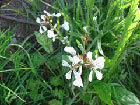 Eruca vesicaria sativa. (60cm x 25cm) The strongly flavoured leaves of rocket have become quite a popular salad ingredient. There is a perennial species with a very similar and probably superior flavour. to the annual species. The annual version can provide salad leaves for much of the year in the milder parts of the country where seeds will germinate and grow all year round. In colder areas it is possible to harvest leaves from mid spring to late autumn.
Eruca vesicaria sativa. (60cm x 25cm) The strongly flavoured leaves of rocket have become quite a popular salad ingredient. There is a perennial species with a very similar and probably superior flavour. to the annual species. The annual version can provide salad leaves for much of the year in the milder parts of the country where seeds will germinate and grow all year round. In colder areas it is possible to harvest leaves from mid spring to late autumn.
 Papaver somniferum. (60cm x 20cm) Surprisingly few people know that the opium poppy is also grown as a food crop, yet this is the plant that those delicious little blue seeds come that are used as a topping on bread and rolls. Opium poppies are also commonly grown as an ornamental crop for their delicate flowers (in the British climate yields of the drug opium from the sap of the plant are so low that it is perfectly legal to grow the plant). This is an excellent plant to grow amongst the annuals. When growing the plant for its seed, allow the seed capsules to dry on the plant before harvesting the whole capsule and tipping the seed out. You may then want to tip some of the seed onto the garden for next year's crop.
Papaver somniferum. (60cm x 20cm) Surprisingly few people know that the opium poppy is also grown as a food crop, yet this is the plant that those delicious little blue seeds come that are used as a topping on bread and rolls. Opium poppies are also commonly grown as an ornamental crop for their delicate flowers (in the British climate yields of the drug opium from the sap of the plant are so low that it is perfectly legal to grow the plant). This is an excellent plant to grow amongst the annuals. When growing the plant for its seed, allow the seed capsules to dry on the plant before harvesting the whole capsule and tipping the seed out. You may then want to tip some of the seed onto the garden for next year's crop.
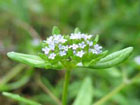 Valerianella species (30cm x 20cm). There are two different species of this genus that make excellent salad plants, V. locusta, corn salad, and V. eriocarpa Italian corn salad. The seeds of these plants are more commonly sown in late summer in order to provide mild-flavoured leaves for the salad bowl throughout the winter.
Valerianella species (30cm x 20cm). There are two different species of this genus that make excellent salad plants, V. locusta, corn salad, and V. eriocarpa Italian corn salad. The seeds of these plants are more commonly sown in late summer in order to provide mild-flavoured leaves for the salad bowl throughout the winter.
When allowing the plants to self-sow, most germination is likely to take place in the spring and summer and so will not be as suitable as a winter crop. If this happens to you then it would be a good idea to harvest some of the seed and sow it yourself in late summer.
Group 2 - Plants that can be sown in situ.
The method of establishing the plants here is exactly the same as for the self-sowers mentioned earlier, with the exception that you have to do it every year since the plants are not vigorous enough to maintain themselves by self-sowing. See the section on the self-sowers for general information on sowing the seed.
The main requirements here are that the seed is able to germinate rapidly after being sown and that the growth of the young plant is vigorous enough to establish the plant amongst the perennials. There are lots of conventional vegetables that fit into this category, as well as several interesting but less well known plants.
The well-known species are the onions and shallots (use onion sets if growing in situ, onion seed will need to be sown in pots), Allium cepa (30cm x 15cm); then there are the many forms of Brassica oleracea such as the cabbage (30cm x 30cm), kale (80cm x 50cm), broccoli (90cm x 60cm), cauliflower (75cm x 50cm), Brussels sprouts (120cm x 30cm) and Kohl rabi (45cm x 25cm); Brassica napus napobrassica, the swede (60cm x 30cm); the many forms of Brassica rapa including turnips (30cm x 20cm) and Chinese cabbages (40cm x 25cm); the forms of Beta vulgaris including beetroot (35cm x 20cm) and Swiss chard (40cm x 30cm); then there is perhaps the easiest of all annual crops the radish, Raphanus sativus 20cm x 10cm); Spinacia oleracea Spinach (30cm x 20cm); and the broad bean, Vicia faba (100cm x 20cm). In addition, potato tubers, Solanum tuberosum (70cm x 30cm), can also be planted in situ.
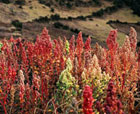 Chenopodium quinoa. (150cm x 25cm) Quinoa has long been cultivated in S. America as a cereal crop and it is now being more widely grown in other regions of the world as a trouble-free, productive and highly nutritious food. The seed is unusual amongst plant foods in that it is a complete protein with the same biological value as milk (most plant proteins are lacking in certain essential amino acids and need to be combined in order to provide a complete protein). The seed germinates very quickly and plants grow away rapidly. If the right varieties are chosen, yields in Britain can be very good. Ken Fern got a good yield from the cultivar ‘Dave’ though he noted that in wet seasons the dense seed heads can retain moisture and cause the seed to rot. In such a situation it is better to grow lower yielding varieties such as ‘Temuco’ or ‘Faro’, which have more open flower heads.
Chenopodium quinoa. (150cm x 25cm) Quinoa has long been cultivated in S. America as a cereal crop and it is now being more widely grown in other regions of the world as a trouble-free, productive and highly nutritious food. The seed is unusual amongst plant foods in that it is a complete protein with the same biological value as milk (most plant proteins are lacking in certain essential amino acids and need to be combined in order to provide a complete protein). The seed germinates very quickly and plants grow away rapidly. If the right varieties are chosen, yields in Britain can be very good. Ken Fern got a good yield from the cultivar ‘Dave’ though he noted that in wet seasons the dense seed heads can retain moisture and cause the seed to rot. In such a situation it is better to grow lower yielding varieties such as ‘Temuco’ or ‘Faro’, which have more open flower heads.
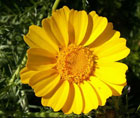 Chrysanthemum coronarium. (60cm x 60cm) Chop-suey greens are commonly grown as a food crop in the Orient, whilst being more seen as an ornamental plant in Britain. The young shoots and stems have a strongly aromatic flavour and are rather an acquired taste, though many people are fond of them. They can be cooked as a potherb (do not overcook or they will turn bitter) or the young leaves can be added to mixed salads. Start harvesting the plant when it is about 4 - 5 weeks old and harvest it quite severely to increase productivity and keep the plant smaller. This is a plant that will self-sow successfully in some gardens so, if you grow it and allow it to flower keep a look out for any seedlings in subsequent years.
Chrysanthemum coronarium. (60cm x 60cm) Chop-suey greens are commonly grown as a food crop in the Orient, whilst being more seen as an ornamental plant in Britain. The young shoots and stems have a strongly aromatic flavour and are rather an acquired taste, though many people are fond of them. They can be cooked as a potherb (do not overcook or they will turn bitter) or the young leaves can be added to mixed salads. Start harvesting the plant when it is about 4 - 5 weeks old and harvest it quite severely to increase productivity and keep the plant smaller. This is a plant that will self-sow successfully in some gardens so, if you grow it and allow it to flower keep a look out for any seedlings in subsequent years.
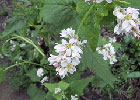 Fagopyrum esculentum. (150cm x 30cm) Buckwheat is often cultivated for its edible seeds, but it also provides very nutritious leaves. Although the flavour of these leaves is not really wonderful, they are an excellent source of rutin, a nutrient that has been shown to have a very beneficial effect upon blood circulation. We find the best way to eat them is to either add a few young leaves to a mixed salad or to cook older leaves in a mixture with other leaves such as spinach or cabbage. The seed has a nutty flavour, though it has a somewhat gritty texture. It can be used as a cereal and is often made into foods such as pancakes and noodles.
Fagopyrum esculentum. (150cm x 30cm) Buckwheat is often cultivated for its edible seeds, but it also provides very nutritious leaves. Although the flavour of these leaves is not really wonderful, they are an excellent source of rutin, a nutrient that has been shown to have a very beneficial effect upon blood circulation. We find the best way to eat them is to either add a few young leaves to a mixed salad or to cook older leaves in a mixture with other leaves such as spinach or cabbage. The seed has a nutty flavour, though it has a somewhat gritty texture. It can be used as a cereal and is often made into foods such as pancakes and noodles.
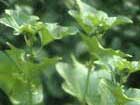 Malva verticillata. (150cm x 50cm) Chinese mallow is a truly excellent salad plant with large mild flavoured tender leaves. A very productive and easily harvested crop, plants with leaves 30cm across can still be good to eat. They make a tasty alternative to the lettuce. This plant is supposed to be a bit tender in Britain, but specimens have been seen to thrive on a north facing slope at 150 metres above sea level in Shropshire. Where possible, try to obtain the cultivar ‘Crispa’ which has more ornamental leaves and a better flavour.
Malva verticillata. (150cm x 50cm) Chinese mallow is a truly excellent salad plant with large mild flavoured tender leaves. A very productive and easily harvested crop, plants with leaves 30cm across can still be good to eat. They make a tasty alternative to the lettuce. This plant is supposed to be a bit tender in Britain, but specimens have been seen to thrive on a north facing slope at 150 metres above sea level in Shropshire. Where possible, try to obtain the cultivar ‘Crispa’ which has more ornamental leaves and a better flavour.
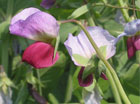 Pisum sativum. (60cm or more x 30cm) The garden pea is a very well known vegetable, but I have included it here because of its growth habit. Whilst there are dwarf cultivars growing only 60cm or so tall, it is also possible to obtain some of the older much taller varieties that will climb into other plants and support themselves by means of their tendrils. It is well worth getting hold of one of these old varieties and allowing it to scramble its way into a shrub or even a hedge. Yields will tend to be a bit lower, but there will be none of the work involved in providing supports for the plant and some consider that the flavour of some of these old varieties of peas has never been matched by the newer dwarf forms. An added benefit of growing peas in this way is that when the plants are removed (cut them off at ground level and leave the roots) then as the roots rot they will provide nearby plants with a good supply of nitrogen to promote their growth.
Pisum sativum. (60cm or more x 30cm) The garden pea is a very well known vegetable, but I have included it here because of its growth habit. Whilst there are dwarf cultivars growing only 60cm or so tall, it is also possible to obtain some of the older much taller varieties that will climb into other plants and support themselves by means of their tendrils. It is well worth getting hold of one of these old varieties and allowing it to scramble its way into a shrub or even a hedge. Yields will tend to be a bit lower, but there will be none of the work involved in providing supports for the plant and some consider that the flavour of some of these old varieties of peas has never been matched by the newer dwarf forms. An added benefit of growing peas in this way is that when the plants are removed (cut them off at ground level and leave the roots) then as the roots rot they will provide nearby plants with a good supply of nitrogen to promote their growth.
 Portulaca oleracea. (25cm x 25cm). There are two forms of purslane, one with green leaves and a cultivated form with yellow/golden leaves. Both of them make very acceptable salad plants. Growing rapidly from seed, it can be ready for harvesting when only 6 weeks old. A frost-tender plant, it is grown as an annual in Britain but, where the climate suits it better, it can become an invasive weed, spreading freely by means of its seed. The leaves have a somewhat sour flavour, when young they make a delicious addition to mixed salads. Older leaves are best cooked and used as a potherb - they are rather mucilaginous and have been used as a substitute for okra for thickening soups. Purslane leaves, unlike most leaves, are a reasonable source of omega-3 fatty acids, though seed sources such as walnuts are many times richer. The seed is also edible, although it is rather small and fiddly to utilize.
Portulaca oleracea. (25cm x 25cm). There are two forms of purslane, one with green leaves and a cultivated form with yellow/golden leaves. Both of them make very acceptable salad plants. Growing rapidly from seed, it can be ready for harvesting when only 6 weeks old. A frost-tender plant, it is grown as an annual in Britain but, where the climate suits it better, it can become an invasive weed, spreading freely by means of its seed. The leaves have a somewhat sour flavour, when young they make a delicious addition to mixed salads. Older leaves are best cooked and used as a potherb - they are rather mucilaginous and have been used as a substitute for okra for thickening soups. Purslane leaves, unlike most leaves, are a reasonable source of omega-3 fatty acids, though seed sources such as walnuts are many times richer. The seed is also edible, although it is rather small and fiddly to utilize.
Traditionally, it was ground into a powder and mixed with cereals for use in gruels, bread, pancakes etc.
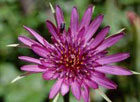 Tragopogon porrifolius. (60cm x 30cm) Salsify is occasionally cultivated in the garden
Tragopogon porrifolius. (60cm x 30cm) Salsify is occasionally cultivated in the garden
for its edible roots, if allowed to flower then it is also quite an ornamental plant. The flavour of the root is mild and sweet, and is said to resemble oysters. Young roots can be grated and eaten raw in salads, whilst older roots are best cooked. The young shoots, harvested shortly after coming through the ground in spring, are also edible, either raw or cooked, and have a sweet taste.
Group 3 - Plants that are sown in pots
Although it takes more time, and consumes more resources, sowing the seed in pots and growing the plants on for a few weeks is probably the most successful way of integrating annual crops into a perennial garden. The deeper 9cm pots are preferable to the smallest 'thumb' pots, since they allow good root formation before planting out. Sow a few seeds in each pot and then thin either to one plant or a few depending on species (cabbages for example are best thinned to one plant whilst seed crops such as amaranth do well thinned to about three). Plants are put out into the garden once they have a good root system, and must be watered in well to encourage rapid establishment. In dry seasons it might be necessary to water once more.
The majority of annual crops respond well to this method. The main exception is certain root crops such as carrots that really dislike root disturbance and do not grow so well in amongst the perennials. In addition to all the vegetables mentioned in previous sections, the following conventional crops can also be grown in this way:- Allium cepa, the onion (30cm x 15cm) and Allium porrum the leek 40cm x 15cm); celery (60cm x 25cm) and celeriac (60cm x 25cm), which are both forms of Apium graveolens; endive, Cichorium endiva; (40cm x 25cm) chicory, Cichorium intybus (40cm x 25cm); lettuce Lactuca sativa (30cm x 25cm); tomatoes, Lycopersicon esculentum (150cm x 30cm); parsley, Petroselinum crispum (40cm x 25cm); French beans, Phaseolus vulgaris (50cm x 25cm); and
finally, sweet corn, Zea mays (150cm x 30cm).
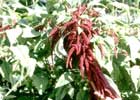 Amaranthus species. The amaranths are very fast growing plants that can provide very nutritious leaves and seeds. Several members of the genus have a long history of cultivation as food crops, especially in S. America and some other areas of the Tropics. They are frost tender plants, which is why it is better to sow them in pots in the spring and then plant them out after the last expected frosts. In warmer climates than Britain it would be possible to sow them in situ. The plants grow best in fertile soil - make sure they are well fed whilst in their pots and apply some compost to the soil when you plant them out and they will repay you with an excellent crop of leaves that you can use as spinach, plus a good crop of small seeds that are very nutritious and an excellent source of protein. Whilst all members of this genus can be eaten, the ones especially recommended are:- A. caudatus, a frequently grown ornamental plant known as love lies bleeding (200cm x 45cm)); A. cruentus, the purple amaranth (200cm x 45cm); A. hybridus, rough pigweed (60cm x 30cm); A. hypochondriacus, prince’s feather (120cm x 50cm); and A. viridis, calalu (50cm x 40cm).
Amaranthus species. The amaranths are very fast growing plants that can provide very nutritious leaves and seeds. Several members of the genus have a long history of cultivation as food crops, especially in S. America and some other areas of the Tropics. They are frost tender plants, which is why it is better to sow them in pots in the spring and then plant them out after the last expected frosts. In warmer climates than Britain it would be possible to sow them in situ. The plants grow best in fertile soil - make sure they are well fed whilst in their pots and apply some compost to the soil when you plant them out and they will repay you with an excellent crop of leaves that you can use as spinach, plus a good crop of small seeds that are very nutritious and an excellent source of protein. Whilst all members of this genus can be eaten, the ones especially recommended are:- A. caudatus, a frequently grown ornamental plant known as love lies bleeding (200cm x 45cm)); A. cruentus, the purple amaranth (200cm x 45cm); A. hybridus, rough pigweed (60cm x 30cm); A. hypochondriacus, prince’s feather (120cm x 50cm); and A. viridis, calalu (50cm x 40cm).
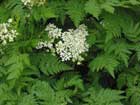 Anthriscus cerefolium (30cm x 25cm) The leaves of chervil have a mild aromatic flavour that is suggestive of aniseed. They can be available all year round and make a nice addition to mixed salads, and can also be used as a flavouring in cooked foods such as soups and stews. They form the basis of the seasoning ‘fines herbes’ and are an essential ingredient of ‘bouquet garni’. The leaves should always be used fresh because the delicate flavour does not withstand drying or prolonged cooking. This is a plant that needs to be sown every few weeks during the growing season in order to ensure a continuous supply of leaves. The earliest sowings can be made in late winter with the final sowing taking place in mid autumn. Whilst the spring, autumn and winter crops are best in a sunny position, the summer crop will do better if given some shade.
Anthriscus cerefolium (30cm x 25cm) The leaves of chervil have a mild aromatic flavour that is suggestive of aniseed. They can be available all year round and make a nice addition to mixed salads, and can also be used as a flavouring in cooked foods such as soups and stews. They form the basis of the seasoning ‘fines herbes’ and are an essential ingredient of ‘bouquet garni’. The leaves should always be used fresh because the delicate flavour does not withstand drying or prolonged cooking. This is a plant that needs to be sown every few weeks during the growing season in order to ensure a continuous supply of leaves. The earliest sowings can be made in late winter with the final sowing taking place in mid autumn. Whilst the spring, autumn and winter crops are best in a sunny position, the summer crop will do better if given some shade.
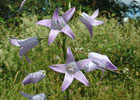 Campanula rapunculus. (50cm x 30cm) Rampion was at one time a popular root crop but fell out of favour due mainly to its low yields. This is rather a since the root has a very nice sweet flavour, which some people say is reminiscent of walnuts. They can be eaten both eaten raw and cooked, perhaps grated into salads or cooked with a mixture of other roots such as carrots. The leaves can also be eaten raw or cooked - they have a fairly bland flavour, with a hint of sweetness and are quite acceptable in salads. This is a very attractive plant if you allow it to flower, which it will do in its second year because it is a biennial.
Campanula rapunculus. (50cm x 30cm) Rampion was at one time a popular root crop but fell out of favour due mainly to its low yields. This is rather a since the root has a very nice sweet flavour, which some people say is reminiscent of walnuts. They can be eaten both eaten raw and cooked, perhaps grated into salads or cooked with a mixture of other roots such as carrots. The leaves can also be eaten raw or cooked - they have a fairly bland flavour, with a hint of sweetness and are quite acceptable in salads. This is a very attractive plant if you allow it to flower, which it will do in its second year because it is a biennial.
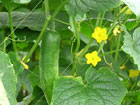 Cucumis sativa. (200cm x 50cm) At first sight, you would not really think of growing cucumbers amongst the perennials, but it can work well. The trick is to treat it as a climbing plant and place it near a shrub that it can grow into. Make sure it is a sturdy shrub, because the weight of the cucumber plant and its fruit is quite considerable and would quite likely break the branches of weaker growing shrubs.
Cucumis sativa. (200cm x 50cm) At first sight, you would not really think of growing cucumbers amongst the perennials, but it can work well. The trick is to treat it as a climbing plant and place it near a shrub that it can grow into. Make sure it is a sturdy shrub, because the weight of the cucumber plant and its fruit is quite considerable and would quite likely break the branches of weaker growing shrubs.
 Cucurbita pepo. (100cm x 120cm) Here we are talking about the bush forms of marrow and courgette, not the vigorous trailing types of pumpkin that can send out shoots 5 metres or more in length. Even these bush forms are rather large to fit among the perennials, but there are times when a gap this large is available, either when a new bed of perennials is just being established and large gaps have been left for the new plants to expand into, or in the unfortunate event that a plant has died and left a big hole behind.
Cucurbita pepo. (100cm x 120cm) Here we are talking about the bush forms of marrow and courgette, not the vigorous trailing types of pumpkin that can send out shoots 5 metres or more in length. Even these bush forms are rather large to fit among the perennials, but there are times when a gap this large is available, either when a new bed of perennials is just being established and large gaps have been left for the new plants to expand into, or in the unfortunate event that a plant has died and left a big hole behind.
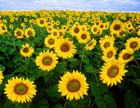 Helianthus annuus. (300cm x 30cm) Sunflowers are tall, stately plants, but they have quite a narrow growth habit and take up surprisingly little space on the ground. Commonly cultivated for their edible seeds, they really need a hotter and drier summer than is usual in Britain in order to develop and ripen their seeds without rotting. When started off early in pots, however, they will usually ripen their seeds successfully in most parts of Britain. The oil-rich seeds have a delicious nutty flavour and can be eaten raw or cooked - the oil is often extracted and is commonly used in cooking, as a salad dressing etc. There are several lower growing cultivars of sunflowers that are easier to grow in Britain, but make sure it is a form with larger seeds since several of these dwarf forms have seeds that are too small to be of much use.
Helianthus annuus. (300cm x 30cm) Sunflowers are tall, stately plants, but they have quite a narrow growth habit and take up surprisingly little space on the ground. Commonly cultivated for their edible seeds, they really need a hotter and drier summer than is usual in Britain in order to develop and ripen their seeds without rotting. When started off early in pots, however, they will usually ripen their seeds successfully in most parts of Britain. The oil-rich seeds have a delicious nutty flavour and can be eaten raw or cooked - the oil is often extracted and is commonly used in cooking, as a salad dressing etc. There are several lower growing cultivars of sunflowers that are easier to grow in Britain, but make sure it is a form with larger seeds since several of these dwarf forms have seeds that are too small to be of much use.
 Lens culinaris. (45cm x 25cm.) It is not widely known that lentils are quite hardy plants that can succeed outdoors at least in the warmer areas of Britain. Although yields per plant are quite low, the seed is a very nutritious and easily digested protein-rich food. They are used in a variety of cooked dishes, they can be dried ground into a flour and added to wheat when making bread etc, or they can be sprouted and used in salads.
Lens culinaris. (45cm x 25cm.) It is not widely known that lentils are quite hardy plants that can succeed outdoors at least in the warmer areas of Britain. Although yields per plant are quite low, the seed is a very nutritious and easily digested protein-rich food. They are used in a variety of cooked dishes, they can be dried ground into a flour and added to wheat when making bread etc, or they can be sprouted and used in salads.
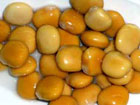 Lupinus species. When talking about lupins, most people will think of the stately flowering plants so often seen in the flower border. However, there are a number of species that have been cultivated for their protein-rich seeds which can be used in any of the ways that soya beans are used. These seeds often have a bitter flavour that needs to be removed by soaking them in water for 12 hours, the water being discarded before cooking them. The three species most commonly cultivated as food crops are L. albus, the white lupin (120cm x 25cm); L. angustifolius, the blue lupin (100cm x 25cm); and L. mutabilis, the pearl lupin (150cm x 25cm). There are several named varieties, including some that have much reduced levels of the bitter substances.
Lupinus species. When talking about lupins, most people will think of the stately flowering plants so often seen in the flower border. However, there are a number of species that have been cultivated for their protein-rich seeds which can be used in any of the ways that soya beans are used. These seeds often have a bitter flavour that needs to be removed by soaking them in water for 12 hours, the water being discarded before cooking them. The three species most commonly cultivated as food crops are L. albus, the white lupin (120cm x 25cm); L. angustifolius, the blue lupin (100cm x 25cm); and L. mutabilis, the pearl lupin (150cm x 25cm). There are several named varieties, including some that have much reduced levels of the bitter substances.
 Phaseolus coccineus. (200cm x 100cm) Runner beans are quite large vigorous climbing plants, but you can grow them successfully in the perennial garden if you allow them to scramble into taller shrubs or a hedge. Since you are likely to be harvesting the seedpods on an almost daily basis in the summer, do make sure you pick a spot that is easily accessible and does not require you to go trampling all over your other plants to get at them.
Phaseolus coccineus. (200cm x 100cm) Runner beans are quite large vigorous climbing plants, but you can grow them successfully in the perennial garden if you allow them to scramble into taller shrubs or a hedge. Since you are likely to be harvesting the seedpods on an almost daily basis in the summer, do make sure you pick a spot that is easily accessible and does not require you to go trampling all over your other plants to get at them.
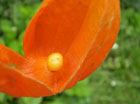 Physalis species. (90cm x 80cm) There are two closely related species of tomatillo, P. ixocarpa and P. philadelphica. They both produce an edible fruit that is wrapped up in a papery husk. Related to tomatoes, it can be a delicious replacement for that fruit in cooked dishes such as stews. The fruit can also be eaten raw, but it needs to be very ripe, and even then it is not the type of fruit that many people would like to eat in quantity.
Physalis species. (90cm x 80cm) There are two closely related species of tomatillo, P. ixocarpa and P. philadelphica. They both produce an edible fruit that is wrapped up in a papery husk. Related to tomatoes, it can be a delicious replacement for that fruit in cooked dishes such as stews. The fruit can also be eaten raw, but it needs to be very ripe, and even then it is not the type of fruit that many people would like to eat in quantity.
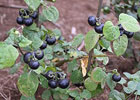 Solanum scabrum / S. lanceifolium
Solanum scabrum / S. lanceifolium
(60cm x 30cm). Looking very similar to our native black nightshade, S. nigrum, the garden huckleberry has been selectively bred to produce an edible fruit which can be cooked and used in preserves, jams and pies. A pleasant musky taste, a few may be eaten raw, though only the fully ripe fruits should be used since the unripe fruits contain small amounts of the toxin solanine (which is also found in potatoes).
Group 4 -The ‘pains in the butt’
These are the plants that, for various reasons, Ken Fern categorised as too difficult to fit into a perennial garden, or where particular care needed to be taken. This was because the sheer size of the plants in question is likely to swamp the perennials, or they are slow to germinate and grow. Each plant will be discussed below.
 Arctium lappa.(200cm x 100cm) Whilst burdock is thought of mainly as a wild plant and occasional garden weed in Britain, it is a commonly cultivated food crop in Japan where a number of named varieties have been developed. Tolerant of some shade, this large plant needs to be grown where there is plenty of room for it if you are going to let it flower and set seed (it can be up to 2 metres tall and 1 metre wide) and there is a risk that it will swamp any smaller plants nearby. If growing amongst perennials, it really needs to be amongst shrubs. Burdock’s edible root is quite thin but long and so you also have to take into account being able to dig in the soil to get the root up. The root can be eaten raw when it is very young, but it is more usual to let it grow larger and then cook it. The flavour is mild and it has the ability, like potatoes, to absorb the flavour of other foods it is cooked with. Burdock is a very healthy food, indeed it is also used as a medicinal herb because of its ability to help clear the body of toxins. A clear case of food being a medicine and medicine being a food!
Arctium lappa.(200cm x 100cm) Whilst burdock is thought of mainly as a wild plant and occasional garden weed in Britain, it is a commonly cultivated food crop in Japan where a number of named varieties have been developed. Tolerant of some shade, this large plant needs to be grown where there is plenty of room for it if you are going to let it flower and set seed (it can be up to 2 metres tall and 1 metre wide) and there is a risk that it will swamp any smaller plants nearby. If growing amongst perennials, it really needs to be amongst shrubs. Burdock’s edible root is quite thin but long and so you also have to take into account being able to dig in the soil to get the root up. The root can be eaten raw when it is very young, but it is more usual to let it grow larger and then cook it. The flavour is mild and it has the ability, like potatoes, to absorb the flavour of other foods it is cooked with. Burdock is a very healthy food, indeed it is also used as a medicinal herb because of its ability to help clear the body of toxins. A clear case of food being a medicine and medicine being a food!
 Chaerophyllum bulbosum (30cm x 30cm). Turnip-rooted chervil has occasionally been cultivated for its edible root. It is a very easily cultivated plant, once the seed has germinated and herein lies the problem. The seed can be very slow to germinate and really needs to be sown in the autumn as soon as it is ripe. Older seed may take 12 months to germinate. The plant is also rather intolerant of root disturbance so needs to be planted out as soon as possible. This is a plant that might be able to self-sow and maintain itself in the garden - allow at least a few plants to flower and scatter their seeds and keep a sharp eye open for seedlings when weeding the garden. But after all this trouble, is the plant worth it? Well, the root is fairly small so overall yields are not high, but it has an excellent aromatic flavour and can be eaten either raw or cooked. When raw it is quite starchy, but becomes sweet and has a floury texture when cooked.
Chaerophyllum bulbosum (30cm x 30cm). Turnip-rooted chervil has occasionally been cultivated for its edible root. It is a very easily cultivated plant, once the seed has germinated and herein lies the problem. The seed can be very slow to germinate and really needs to be sown in the autumn as soon as it is ripe. Older seed may take 12 months to germinate. The plant is also rather intolerant of root disturbance so needs to be planted out as soon as possible. This is a plant that might be able to self-sow and maintain itself in the garden - allow at least a few plants to flower and scatter their seeds and keep a sharp eye open for seedlings when weeding the garden. But after all this trouble, is the plant worth it? Well, the root is fairly small so overall yields are not high, but it has an excellent aromatic flavour and can be eaten either raw or cooked. When raw it is quite starchy, but becomes sweet and has a floury texture when cooked.
 Cucurbita species. (100cm x 500cm) Pumpkins and squashes are very vigorous plants and, since their shoots can be 6 metres or more long, they are much too large to be able to fit into your average flower bed. For those who have the space, it would be worthwhile experimenting with growing them on the sunny side of a shrubbery or even on the south or southwest edge of woodland. Here these climbing plants (for that is what they are in the wild) will spread out over the ground and clamber up into any surrounding plants that they can get a hold of.
Cucurbita species. (100cm x 500cm) Pumpkins and squashes are very vigorous plants and, since their shoots can be 6 metres or more long, they are much too large to be able to fit into your average flower bed. For those who have the space, it would be worthwhile experimenting with growing them on the sunny side of a shrubbery or even on the south or southwest edge of woodland. Here these climbing plants (for that is what they are in the wild) will spread out over the ground and clamber up into any surrounding plants that they can get a hold of.
 Daucus carota sativus. (30cm x 30cm). There are several problems with growing carrots amongst perennials. Firstly, the seed is quite slow to germinate, then the seedlings are frail and slow growing at first. These problems can be easily overcome by sowing the seed in pots as per the previous section - unfortunately the seedlings are very intolerant of root disturbance and plants will not develop good quality roots if they are disturbed. And growing them in 9cm pots does not work since the roots have reached the bottom of the pot before the tops are large enough to plant out - this results in poor quality deformed roots. You could sow the seed in deeper pots, but this is very wasteful of resources, and you soon begin to wonder if it is worthwhile.
Daucus carota sativus. (30cm x 30cm). There are several problems with growing carrots amongst perennials. Firstly, the seed is quite slow to germinate, then the seedlings are frail and slow growing at first. These problems can be easily overcome by sowing the seed in pots as per the previous section - unfortunately the seedlings are very intolerant of root disturbance and plants will not develop good quality roots if they are disturbed. And growing them in 9cm pots does not work since the roots have reached the bottom of the pot before the tops are large enough to plant out - this results in poor quality deformed roots. You could sow the seed in deeper pots, but this is very wasteful of resources, and you soon begin to wonder if it is worthwhile.
 Pastinaca sativa. (50cm x 25cm). Parsnip seed is even slower to germinate than carrot seed and, with regard to inclusion in a perennial plants scheme, parsnip suffers from the same problems as carrot (see above).
Pastinaca sativa. (50cm x 25cm). Parsnip seed is even slower to germinate than carrot seed and, with regard to inclusion in a perennial plants scheme, parsnip suffers from the same problems as carrot (see above).
Conclusion
There are many annuals that fit in quite easily amongst perennial plants and growing them in this way can be a very productive and sustainable use of the land. In addition, you will usually find a considerable drop in the amount of damage caused to plants by pests and diseases - even if some plants get attacked, it is very likely that others will escape completely simply because they are isolated from the attacked plants.
There are also several annual crops that do not fit so well into a perennial system, and rather than worrying about these difficulties, perhaps it is better to find acceptable substitutes from amongst the thousands of perennial plants that have been overlooked as food sources.
Database
The database has more details on these plants: Allium cepa, Allium porrum, Amaranthus caudatus, Amaranthus cruentus, Amaranthus hybridus, Amaranthus hypochondriacus, Amaranthus species, Amaranthus viridis, Anthriscus cerefolium, Apium graveolens, Arctium lappa, Atriplex hortensis, Barbarea verna, Beta vulgaris, Beta vulgaris cicla, Brassica napus napobrassica, Brassica oleracea, Brassica rapa, Campanula rapunculus, Chaerophyllum bulbosum, Chenopodium album, Chenopodium quinoa, Chrysanthemum coronarium, Cichorium endiva, Cichorium intybus, Claytonia perfoliata, Claytonia sibirica, Cucumis sativa, Cucurbita pepo, Cucurbita species, Daucus carota sativus, Eruca vesicaria sativa, Fagopyrum esculentum, Helianthus annuus, Lactuca sativa, Lens culinaris, Lupinus albus, Lupinus angustifolius, Lupinus mutabilis, Lupinus species, Lycopersicon esculentum, Malva verticillata, Papaver somniferum, Pastinaca sativa, Petroselinum crispum, Phaseolus coccineus, Phaseolus vulgaris, Physalis ixocarpa, Physalis philadelphica, Pisum sativum, Portulaca oleracea, Raphanus sativus, Solanum nigrum, Solanum scabrum, Solanum tuberosum, Spinacia oleracea, Tragopogon porrifolius, Valerianella eriocarpa, Valerianella locusta, Vicia faba, Zea mays.